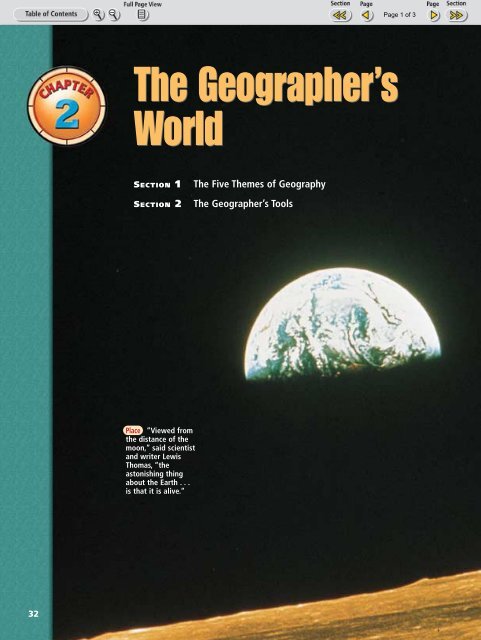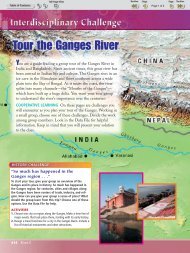The Geographer’s World
The Geographer's World The Geographer's World
The Geographer's World The Geographer's World
- No tags were found...
You also want an ePaper? Increase the reach of your titles
YUMPU automatically turns print PDFs into web optimized ePapers that Google loves.
032-033 Chapter 2/EH 10/17/02 11:38 AM Page 32<br />
<strong>The</strong> <strong>Geographer’s</strong><br />
<strong>World</strong><br />
SECTION 1<br />
SECTION 2<br />
<strong>The</strong> Five <strong>The</strong>mes of Geography<br />
<strong>The</strong> <strong>Geographer’s</strong> Tools<br />
Place “Viewed from<br />
the distance of the<br />
moon,” said scientist<br />
and writer Lewis<br />
Thomas, “the<br />
astonishing thing<br />
about the Earth . . .<br />
is that it is alive.”<br />
32
032-033 Chapter 2/EH 10/17/02 11:38 AM Page 33<br />
How has new technology increased<br />
our knowledge of Earth?<br />
Human-Environment Interaction • Terra, the Earth Observing System<br />
(EOS) satellite launched in 1999, helps scientists understand how Earth’s<br />
lands, oceans, air, ice, and plant and animal life work together as a system.<br />
Scientists at the National Aeronautics and Space Administration (NASA) use<br />
sensors mounted on satellites to study Earth’s air, land, and water.<br />
Terra helps to answer such questions as: Which environmental changes<br />
result from natural causes? Which are caused by humans? Satellites like<br />
Terra also help scientists study natural disasters such as hurricanes, volcanic<br />
eruptions, and floods. Today, several countries are working together<br />
in the Earth Observing System program to gather information about<br />
climate and environmental change on Earth.<br />
What do you<br />
think?<br />
♦ How can Terra<br />
benefit people?<br />
♦ Why do countries<br />
work together to<br />
study climate<br />
and environmental<br />
change?<br />
33
034-041 Chapter 2/EH 10/17/02 11:39 AM Page 34<br />
BEFORE YOU READ<br />
>> What Do You Know?<br />
Do you know how to find important places in your town? Have you visited cities,<br />
towns, or rural areas and noticed what made these places special? Do you ever use<br />
terms like “up north” or “back east”? Have you ever moved from one neighborhood,<br />
town, or country to another? Do you know about the harmful effects of pollution<br />
on wildlife habitats? If you answered yes, then you know something about each of<br />
geography’s five big themes—location, place, region, movement, and<br />
human-environment interaction.<br />
>> What Do You Want to Know?<br />
Decide what more you want to learn about geography’s five themes.<br />
Write your ideas, and any questions you may have, in your notebook<br />
before you read this chapter.<br />
READ AND TAKE NOTES<br />
Reading Strategy: Identifying Main Ideas One<br />
way to make sense of what you read is to look<br />
for main ideas and supporting details. Each<br />
paragraph, topic heading, and section in a chapter<br />
usually has a main idea. Supporting details help<br />
to explain the main idea. Use this spider map to<br />
write a main idea and its supporting details from<br />
this chapter.<br />
• Copy the spider map in your notebook.<br />
• As you read, look for information about the<br />
five themes of geography.<br />
• Write a main idea in the center circle.<br />
• Write details supporting the main idea in the<br />
other circles.<br />
Place • Physical and human characteristics reveal<br />
patterns in places. <br />
<strong>The</strong> Five<br />
<strong>The</strong>mes of<br />
Geography<br />
34 CHAPTER 2




